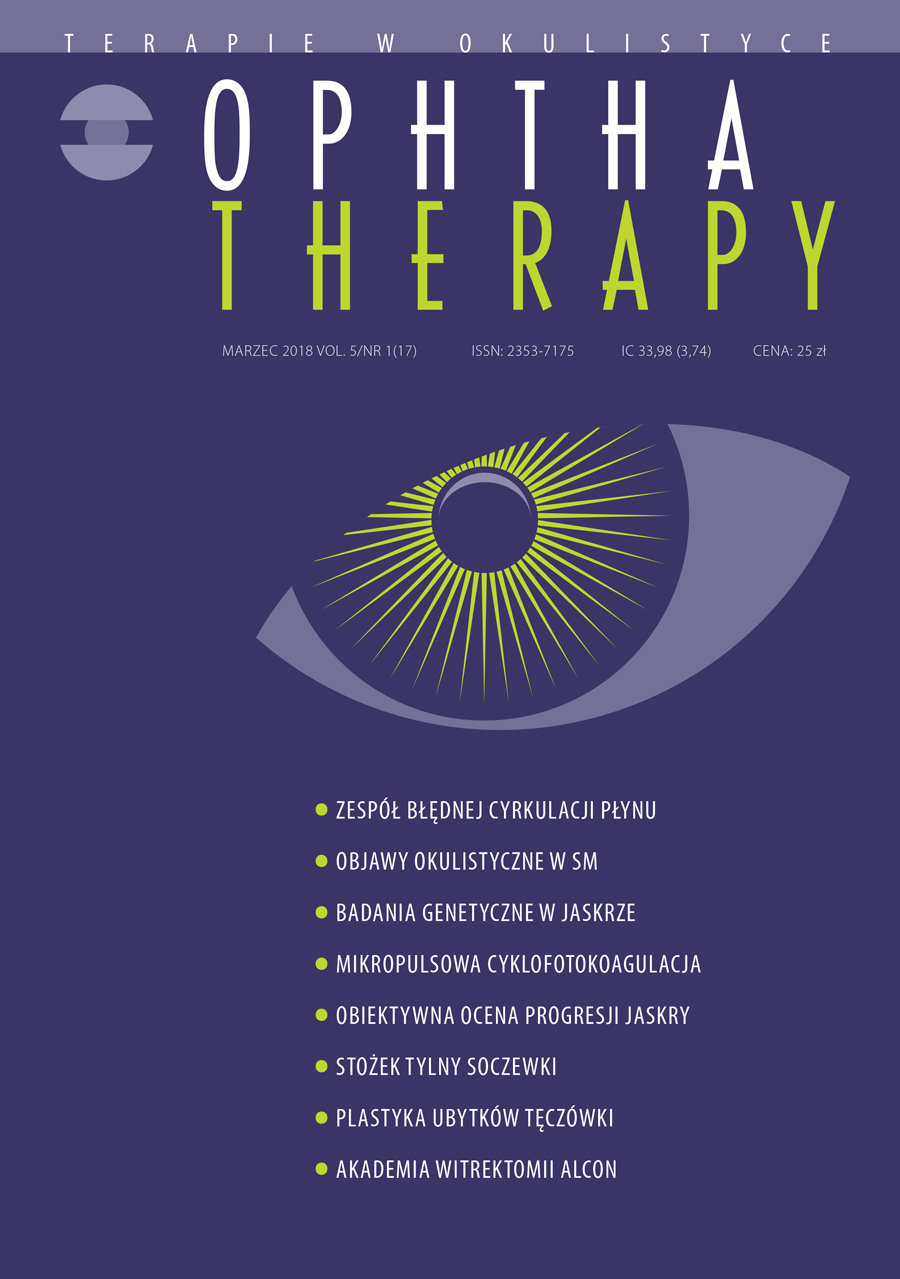Posterior lenticonus – the results of surgical treatment in children
Main Article Content
Abstract
Aim: To present the results of surgical treatment of the posterior lenticonus with implantion of multifocal IOLs in children.
Material and method: Lens aspiration with a multifocal IOL implantion was performed in 22 children aged 1–10 years. Before and during the 2–5-year follow- up, the anterior and posterior eye segment, visual acuity, binocular vision and intraocular pressure were evaluated.
Results: The visual acuity before surgery was ranged from 0.05 to 0.1. After the operation, it improved from 0.1 to 1.0 and depended mainly on the effectiveness of amblyopia treatment. Visual acuity better than 0.3 was found in 81.8% of operated patients. There was a significant improvement in binocular vision in comparison to the preoperative period. In 1 case, the child had to be reoperated due to the IOL dislocation. There were no glaucoma cases in the operated group of children.
Conclusions: Lens aspiration with a multifocal IOL implantation is a method that provide good functional outcomes in operated children. However, the technique of surgery treatment is more difficult than in the patients with congenital cataract due to the very thin and weak posterior lens capsule and occurrence pre-operative capsule tearings.
Downloads
Article Details

This work is licensed under a Creative Commons Attribution-NonCommercial-NoDerivatives 4.0 International License.
Copyright: © Medical Education sp. z o.o. License allowing third parties to copy and redistribute the material in any medium or format and to remix, transform, and build upon the material, provided the original work is properly cited and states its license.
Address reprint requests to: Medical Education, Marcin Kuźma (marcin.kuzma@mededu.pl)
References
2. Cheng KP, Hiles DA, Biglan AW et al. Management of posterior lenticonus. J Pediatr Ophthalmol Strabismus. 1991; 28: 143-9.
3. Russell-Eggitt IM. Non-syndromic posterior lenticonus a cause of childhood cataract: evidence for X-linked inheritance. Eye (Lond). 2000; 14: 861-3.
4. Schipper I, Senn P, Schmid M. Diagnosis and management of bilateral posterior lenticonus in 7 members of the same family. J Cat Refract Surg. 2006; 32: 261-3.
5. Jacobs K, Meire FM. Lenticonus. Bull Soc Belge Ophthalmol. 2000; 277: 65-70.
6. Barraquer RI, Michael R, Abreu R et al. Human lens capsule thickness as a function of age and location along the sagittal lens perimeter. Invest Ophthalmol Vis Sci. 2006; 47: 2053-60.
7. Yang GY, Liu LQ, Liu CL. Surgical treatment and pathologic analysis of posterior lentiglobus with cataract. Int J Ophthalmol. 2011; 4: 572-4.
8. Murakami Y, Kusaka S, Hayashi N et al. Wavefront analysis and ultrastructural findings in an eye with posterior lentiglobus. JAAPOS. 2010; 14: 530-1.
9. Ranjan P, Mishra D, Bhadauria M. Atoll sign in posterior lenticonus: A case report of bilateral posterior lenticonus with review of literature. J Clin Ophthalmol Res. 2014; 2: 152-4.
10. Gul A, Caglar C, Cınal A et al. Ocular biometry and central corneal thickness in children: a hospital-based study. Arq Bras Oftalmol. 2014; 77: 152-4.
11. Mistr SK, Trivedi RH, Wilson ME. Preoperative considerations and outcomes of primary intraocular lens implantation in children with posterior polar and posterior lentiglobus cataract. J AAPOS. 2008; 12: 58-61.
12. Wilson ME, Trivedi RH. Intraocular lens implantation in pediatric eyes with posterior lentiglobus. Trans Am Ophthalmol Soc. 2006; 104: 176-82.
13. Ganesh S, Brar S, Chopra K. Jellyfish sign for intraoperative identification of posterior lenticonus. Intern Ophthalmol. 2017; 37: 1239-41.

